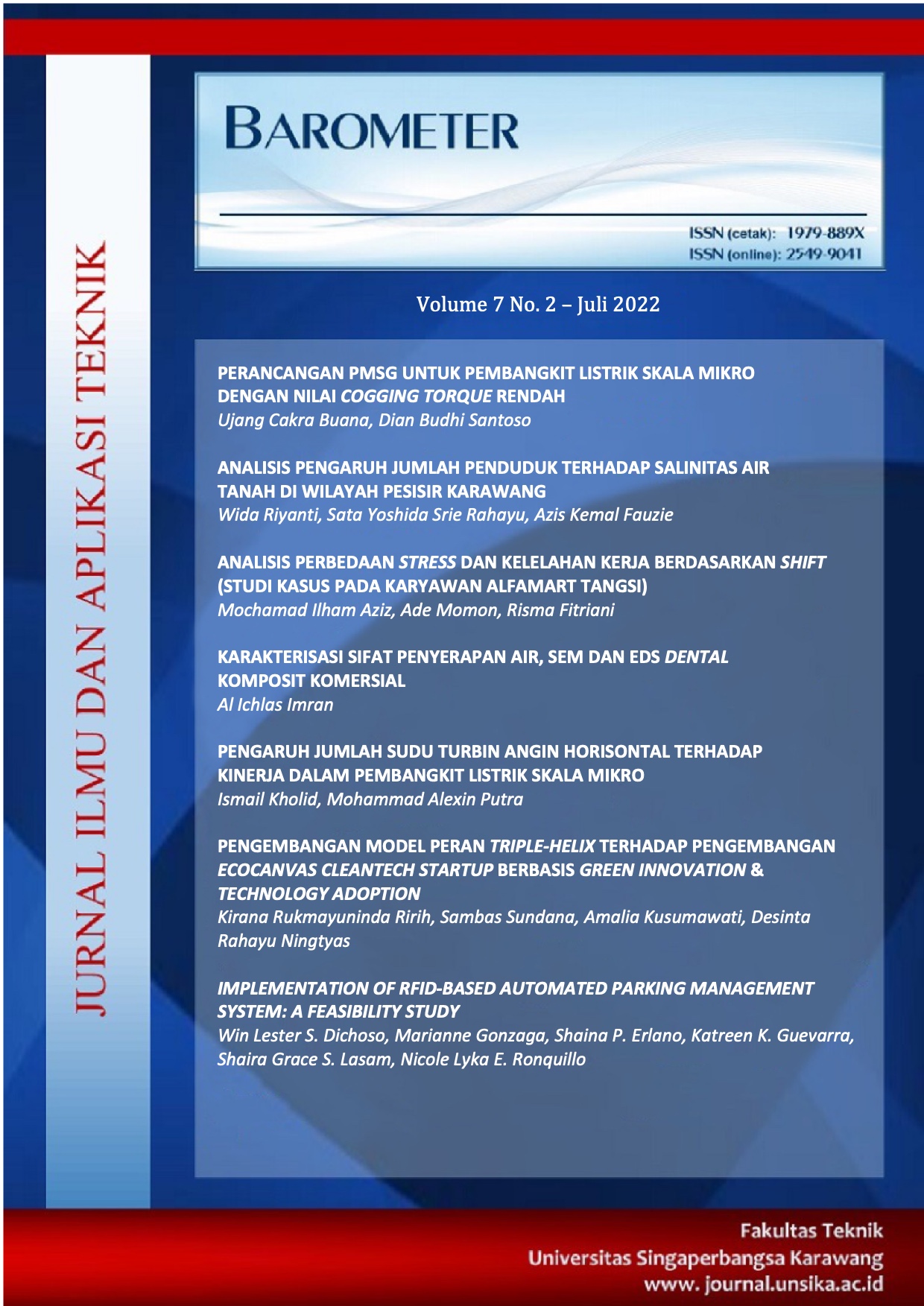PMSG DESIGN FOR MICRO SCALE POWER PLANT WITH LOW COGGING TORQUE VALUE
DOI:
https://doi.org/10.35261/barometer.v7i2.5716Abstract
The need for electrical energy continues to increase along with population growth. it is very important to encourage the use of new and renewable energy to support electricity needs. One of them is the use of wind energy. Wind can be used to drive a turbine coupled to a generator. Permanent magnet synchronous generator (PMSG) is a type of generator that is often used in the utilization of wind energy. The main component of PMSG consists of three components, namely the stator, rotor and permanent magnet. The interaction between the components causes a ripple or often referred to as the cogging phenomenon. Cogging is what makes PMSG not work perfectly. This study discusses the effect of teeth width on decreasing the cogging torque value in PMSG by making two designs. The design variations used are teeth width 7 mm and 4 mm, Carpenter type of iron core: Silicon steel, Permanent magnet synchronous generator 18 slot 16 pole (PMSG 18s16p). The result of decreasing the value of cogging torque obtained is 0.012676 Nm with 4 mm teeth width. For numerical analysis using the finite element method (FEM).
Downloads
References
T. Nur and L. E. Joe, “STUDY OF THE EFFECT OF HEIGHT AND LENGTH OF SLOTTING IN MAGNET EDGE ON THE COGGING TORQUE REDUCTION OF FRACTIONAL SLOT NUMBER IN,” in International Conference on Engineering Science andTechnology (ICEST), Lampung, Indonesia, 2019.
S. Mawar dan T. Nur, “Study the Influenceof Edge Points of Magnet Surface and Stator Core onthe Cogging Torque Reduction in Permanent MagnetMachine,” dalam International Conference on ElectricalEngineering, Science and Technology (ICEST), Lampung, Indonesia, 2019.
E. M. A. Harahap, I. H. Rosma and A. Hamzah, “Analisis Pengaruh Posisi Peletakan Magnet Permanen di Rotor Terhadap Kinerja Generator Sinkron Magnet Permanen,” Jom FTEKNIK, vol. 7, no. 2, pp. 1-2, 2020.
G. E. Pramono, F. Muliawati and N. F. Kurniawan, “DESAIN DAN UJI KINERJA GENERATOR AC FLUKS RADIAL MENGGUNAKAN 12 BUAH MAGNET PERMANEN TIPE NEODYMIUM (NdFeB) SEBAGAI PEMBANGKIT LISTRIK,” Jurnal Teknik Elektro & Sains (JuTEkS), vol. 4, no. 1, p. 34, 2017.
Y. Suherman and T. Nur, “Pengaruh Kombinasi Pemangkasan Ujung Magnet Permanen dan Axial Channel pada inti rotor terhadap Torka Cogging pada Generator Tipe Fractional Slot Number,” JURNAL ELEKTRO, vol. 13, no. 2, p. 2, 2020.
J. F. Gieras and F. , “Analytical Approach to Cogging Torque Calculation of PM Brushless Motors,” IEEE TRANSACTIONS ON INDUSTRY APPLICATIONS, vol. 40, no. 5, p. 1, 2004.
M. M. Nugroho, “Optimalisasi Nilai Cogging torquepada Internal Permanent Magnet SynchronousGenerator Outer Rotor 15 Slot 10 Pole dengan VariasiKeberadaan Umbrella pada Stator dan Lebar Teetth,” PAPER CIHUY / GENERATOR ELEKTRIK, Vol. %1 dari %2-, no. -, p. 1, 2021.
R. Bargallo, Finite Element for ElectricalEngineering, Barcelona: Electrical Engineering Department.University Politecnica De Catalunya, 2006.
H. Pujowidodo, J. Helian, G. . E. Pramono, and A. Ridwan, “Pengembangan Generator Mini Dengan Menggunakan Magnet Permanen,” Departemen Teknik Mesin, Program Pasca Sarjana, Fakultas Teknik Universitas Indonesia, Indonesia, 2008.
P. Irasari, “Metode perancangan generator magnet permanen berbasis pada dimensi stator yang sudah ada,” Ketenagalistrikan dan Energi Baru Terbarukan, vol. 7, no. 1, pp. 15-27, 2008.
I. Raharjo and M. , “The Conversation,” 8 August 2018. [Online]. Available: https://theconversation.com/potensi-energi-angin-di- indonesia-begitu-besar-mengapa-kincirnya-harus- kecil-104498. [Accessed 3 October 2021].



